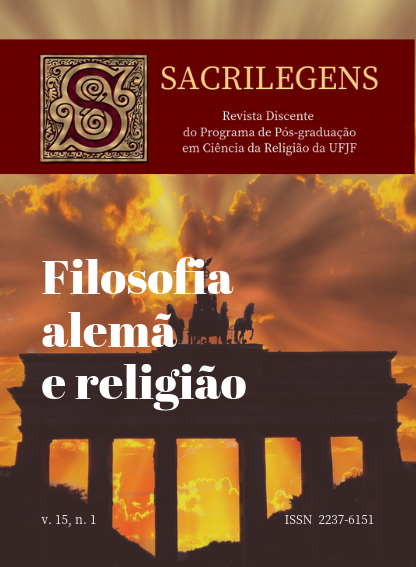As Raízes da Religião na Perspectiva dos Novos Ateístas
DOI:
https://doi.org/10.34019/2237-6151.2018.v15.27065Palavras-chave:
Religião, Naturalismo, Evolucionismo, Neoateísmo, MemesResumo
Este artigo tem por objetivo apresentar os argumentos de Daniel Dennett e de
Richard Dawkins para explicar o surgimento, a presença e a continuidade das religiões na
experiência humano-social conforme elaborados respectivamente em suas obras Breaking the
Spell e The God Delusion.Um ponto comum nos argumentos apresentados por esses autores
neoateístas é que a religião deve ser analisada e explicada pela via biológica e à maneira
darwiniana, isto é, como um processo gradual de evolução cultural.
Downloads
Referências
os Novos Ateístas. Rio de Janeiro: Atualidade Teológica, Ano XVII, n. 43, janeiro a abril de
2013.
ATRAN, S. In Gods We Trust: The Evolutionary Landscape of Religion. New York: Oxford
University Press, 2002.
BEATTIE, Tina. The New Atheists: The Twilight of Reason and the War on Religion.
London:Orbis Books, 2008.
BLACKMORE, Susan. The Meme Machine. Oxford University Press, 1999.
BLAKER, K., (Ed.) The Fundamentals of Extremism: The Christian Right in America.
Plymounth, MI: New Boston, 2003.
BLOOM, Paul. Religion is Natural. The Author. Journal Compilation. Oxford, UK:
Blackwell Publishing, 2007.
BORER, Michael Ian. The New Atheism and the Secularization Thesis. In: AMARNATH,
Amarasingam (Ed.) Religion and the New Atheism: a critical appraisal. Leiden – Boston:
BRILL, 2010.
BOYER, P. Religion Explained: The Evolutionary Origins of Religious Thought. New York:
Basic Books, 2001.
DAWKINS, Richard. The Extended Phenotype. New York: Oxford University Press, 1982.
___________. Deus, um delírio. São Paulo: Companhia das Letras, 2007.
___________. The Selfish Gene. Oxford & New York: Oxford University Press, 1976.
___________. The Blind Watchmaker: Why the Evidence of Evolution Reveals a Universe
without Design, New York: W. W. Norton, 1986.
___________. A Devil’s Chaplain: reflections on hope, lies, science, and love. Boston – New
York: HoughtonMifflinCompany, 2003.
DENNETT, Daniel C. Quebrando o Encanto: A religião como fenômeno natural. São Paulo
Globo 2006.
_____________. Darwin’s dangerous idea: evolution and the meanings of life. New York:
Simon & Schuster, 1995.
DURKHEIM, E. The Elementary Forms of Religious Life(1915).Oxford World’s Classics,
2001.
FOWLER, Thomas B.; KUEBLER, Daniel. The Evolution Controversy: a survey of
competing theories. Michigan: Baker Academic, 2007.
GAUCHET, Marcel. TheDisenchantmentoftheWorld: A PoliticalHistoryofReligion. New
Jersey: Princeton UniversityPress, 1997.
GEERTZ. Clifford. The interpretation of cultures: selected essays. New York, 1973.
HARRIS, Sam. Letter to a Christian Nation. New York: Vintage Books, 2006.
___________. The End of Faith:Religion, Terror, and the Future of Reason. New York:
W.W.Norton, 2004.
HINDE, Robert A. Why Gods Persist: A Scientific Approach to Religion. London:
Routledge, 2010.
____________. Why Good is Good: The Sources of Morality. London: Routledge, 2002
HITCHENS, Christopher. God is not Great: How Religion Poisons Everything. New York:
Haechette Book Group, 2007a.
HUNTER, James C. Culture wars: the struggle to define America. New York: Basic Books,
1991.
JAMES, William. The Varieties of Religious Experience: A Study in Human Nature.
SevenTreasuresPublications, 2009.
RIBEIRO, João M. Gonçalves. Memética: a memória evolui!.Universidade de Lisboa, 2007.
SHERMER, M. Why people believe weird things: Pseudoscience, superstition, and other
confusions of our time. New York: W. H. Freeman, 1997.
WILSON, David Sloan. Darwin’s Cathedral: Evolution, Religion, and the Nature of Society.
Chicago: The University of Chicago Press, 2002.
Downloads
Como Citar
Edição
Seção
Licença
 A Revista Sacrilegens é um periódico de acesso aberto, licenciada sob a licença Creative Commons Attribution 4.0 International
A Revista Sacrilegens é um periódico de acesso aberto, licenciada sob a licença Creative Commons Attribution 4.0 International










